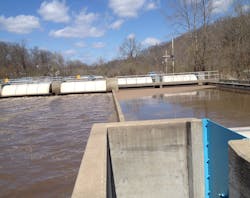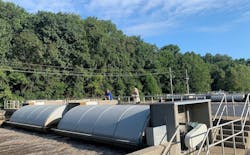About the author:
Chris French is a freelance writer on water, environment and renewable energy issues. French can be reached at chrispodpr@croslandmedia.
In Northwest Arkansas, Bentonville has become one of the most attractive places in America to live. With its rapidly increasing population, it is just as well that those who run the city’s Water Resource Recovery Facility are extremely diligent and a proven group of forward thinkers.
The facility, which mainly receives domestic wastewater, saw its 2019 average daily flow reach 3.7 mgd, up by almost 1 million gallons from 2018.
Bentonville is already well known for being the home of Walmart’s corporate headquarters – the first Walmart store having opened nearby in 1962 — but in the past decade this enterprising city has seen the opening of several major attractions. These include the Crystal Bridges Museum of American Art and The Momentary – not to mention the Razorback Regional Greenway, a spectacular 40-mile bike and pedestrian trail. The city is also very close to the wonders of Ozark National Forest.
The first basic wastewater treatment plant in Bentonville was established in 1940. Today’s facility is an activated sludge plant with extended aeration and was built in 1985. At that time the city installed Lakeside Equipment Corp.’s Closed Loop Reactor (CLR) Process with racetrack configuration that provides a straight-line flow pattern for wastewater between the headworks and the final clarifiers. At the core of the CLR Process is the horizontal Magna Rotor, which sustains a high population of microorganisms in the reactor to provide simple process control.
In 2019, the Bentonville WRRF decided it was time to replace the rotors.
“For us, preventive maintenance is the cornerstone of our industry,” said Bentonville WRRF Operations Supervisor Chris Earl. “Routine oil and belt changes extend the life of bearings and motors. However, you must begin with a quality product”.
Since installation, Earl noted some bearings and the fiberglass covers have been replaced, and none of the rotors had failed in 34 years of operations.
“It is an amazing run for a piece of wastewater equipment,” he said. “Our team could certainly keep this piece of equipment running for several more years, but everything was in place with our budgets. And with Bentonville continuing to grow, we decided the time was right to square everything away for the next 35 years or more”.
Since the CLR was installed in 1985, there have been four upgrades to Bentonville’s WRRF. In 1995, additions were made to the maintenance and operations buildings. In 2000, two 600,000-gallon aerobic digesters and blower buildings were added to improve the solids stabilization process. Also, anoxic basins were added at the North end of the plant for nitrite and nitrate nitrogen removal. In 2005, modifications were made to the anoxic basins to accommodate biological phosphorus removal.
The chlorine disinfection system was replaced by an ultraviolet disinfection system, and in 2009, drying beds were converted to a sludge storage area. Two dump bays were also added to provide an area for Vac-Con trucks and vacuum trailers to unload contaminated material removed from the sewer collection system. This material is allowed to dry and is then applied to land or sent to a local compost facility.
Throughout that entire period, the CLR has kept working. Always on hand to help Chris Earl at the WRRF has been Lakeside’s agent, Phil Shupe of North Little Rock’s Shupe & Associates.
Proper Maintenance is Proactive
“The team at Bentonville, who are very easy to work with, run a very tight ship”, said Phil. “They set a great example for the wastewater industry and for all engineering by showing that it pays to look after equipment. This latest investment in Lakeside is a very wise, proactive measure that makes perfect sense for the city.”
The Lakeside blades are die-formed of 10-gauge AISI Type 304 stainless steel to produce stiffness and rigidity that can take a 250-pound impact load without deformation. The Magna Rotor provides precise oxygen input into the biological process through adjustment of rotor immersion by raising or lowering the level control weir and by adjusting the rotational speed via VFD. Microorganisms are mixed uniformly, and because mixing velocity is brought to the channel, solids are prevented from settling. The Magna Rotor’s design allows a single rotor to span channel widths up to 30 feet, saving money by eliminating the need for additional equipment to join multiple rotor assemblies.
“The exemplary safety record of Lakeside’s equipment also shouldn’t be overlooked,” Shupe said. “With other systems of lesser quality, loosening bolts have seen brushes flying off. These hunks of steel can cause serious harm, so again, as Chris Earl rightly says, preventative maintenance and the need to begin with a top-quality product is very much the right approach and practice”.
The mission statement of the Bentonville WRRF is “protect public health and the environment through effective treatment of wastewater. Effective wastewater treatment prevents disease, contamination of water supply, maintains clean waters for the propagation and survival of fish and aquatic life, and conserves water.”
Aeration in mixed activated sludge basins is, of course, a firm requirement and certainly not an option, so the Bentonville team pulled out all the stops to maintain proper mixing and oxygen levels for maximum treatment quality during the dismantling and replacement of each of the eight Lakeside Magna rotors. The city was determined to protect the local environment by keeping well within permit compliance.
‘Protect and Blend In’
Working closely alongside Earl is Nancy Busen, manager of the Bentonville WRRF.
“The amazing activities we now have in the city are our closest neighbors,” she said. “We feel it is our duty to not only protect but also quietly blend into the new ambiance of the surrounding community where beautiful new housing developments are being built as part of the incredible quality-of-life investments that are being made here.”
She said the 23 employees are state certified for work at the WRRF, and they unrelentingly maintain 59 lift stations throughout the city.
“We are the nation’s fifth fastest-growing city, so we need to keep on our toes,” Busen said.
With a population that grew from 50,000 in 2018 to 55,000 in 2019 – from just 35,000 in 2010, Earl agreed it is imperative to keep investing not only in reliable equipment that is properly maintained, but also reliable staff, who continue to attend industry education classes to broaden and update their knowledge.
“Admittedly the Lakeside equipment is easy to maintain,” Earl said, “but with proper care, we expect to see these new Magna rotors last for a long, long time. Seeing the previous rotors last — and in fact still working after 35 years — is the best possible product recommendation.”
About the Author
Chris French
Chris French is a freelance writer on water, environment and renewable energy issues. French can be reached at [email protected].

